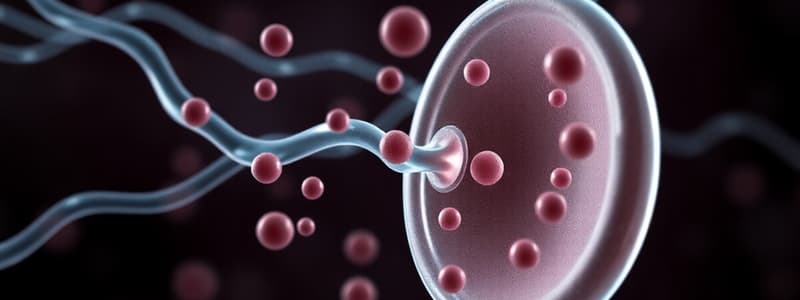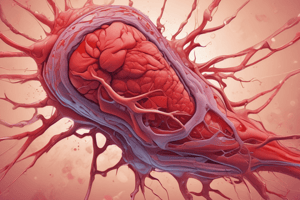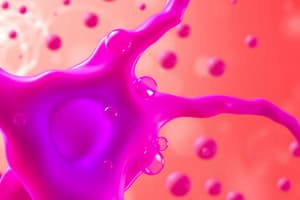Podcast
Questions and Answers
What is the primary function of tissue plasminogen activator (tPA)?
What is the primary function of tissue plasminogen activator (tPA)?
- To activate platelets
- To inhibit thrombin activity
- To convert fibrinogen into fibrin
- To cleave plasminogen into plasmin (correct)
Activated protein C inhibits thrombin and reduces clot formation.
Activated protein C inhibits thrombin and reduces clot formation.
True (A)
What are the small fragments formed from the breakdown of fibrin called?
What are the small fragments formed from the breakdown of fibrin called?
d-dimer
Nitric oxide is a very strong __________ inhibitor produced by endothelial cells.
Nitric oxide is a very strong __________ inhibitor produced by endothelial cells.
Match the following components with their respective roles in hemostasis:
Match the following components with their respective roles in hemostasis:
Which of the following is a component of secondary haemostasis?
Which of the following is a component of secondary haemostasis?
Coagulation factors are typically active enzymes when synthesized.
Coagulation factors are typically active enzymes when synthesized.
What are the two pathways involved in activating the common pathway of secondary haemostasis?
What are the two pathways involved in activating the common pathway of secondary haemostasis?
The conversion of prothrombin to __________ is a crucial step in secondary haemostasis.
The conversion of prothrombin to __________ is a crucial step in secondary haemostasis.
Match the following stages of secondary haemostasis with their descriptions:
Match the following stages of secondary haemostasis with their descriptions:
Which vitamin is essential for the synthesis of certain coagulation factors like II, VII, IX, and X?
Which vitamin is essential for the synthesis of certain coagulation factors like II, VII, IX, and X?
Primary and secondary haemostasis occur sequentially and do not overlap.
Primary and secondary haemostasis occur sequentially and do not overlap.
What initiates the extrinsic pathway?
What initiates the extrinsic pathway?
The intrinsic pathway is activated by contact with negative surfaces.
The intrinsic pathway is activated by contact with negative surfaces.
What is the role of Tissue Factor (TF) in the extrinsic pathway?
What is the role of Tissue Factor (TF) in the extrinsic pathway?
The common pathway leads to the activation of __________.
The common pathway leads to the activation of __________.
Match the following factors with their corresponding pathways:
Match the following factors with their corresponding pathways:
Which factor is activated by FXIIa?
Which factor is activated by FXIIa?
The extrinsic pathway is primarily activated by contact with negatively charged phospholipids.
The extrinsic pathway is primarily activated by contact with negatively charged phospholipids.
Which protein binds to Ca2+ in the common pathway?
Which protein binds to Ca2+ in the common pathway?
The intrinsic pathway is also known as the __________ pathway.
The intrinsic pathway is also known as the __________ pathway.
What is the end product of the common pathway?
What is the end product of the common pathway?
Flashcards
What is secondary haemostasis?
What is secondary haemostasis?
Secondary haemostasis strengthens a weak platelet plug by activating coagulation factors, which are mostly proenzymes (inactive precursors) synthesized in the liver, requiring activation to carry out their function.
Describe the coagulation cascade.
Describe the coagulation cascade.
The coagulation cascade can be described as a series of steps involving the activation of a specific set of coagulation factors (proenzymes), culminating in the formation of thrombin, which then converts fibrinogen into fibrin.
Explain the extrinsic pathway.
Explain the extrinsic pathway.
The extrinsic pathway is initiated by tissue factor (TF), a protein released from damaged tissue cells, which interacts with factor VII (VIIa) and leads to the activation of factor X, a key coagulation factor.
Describe the intrinsic pathway.
Describe the intrinsic pathway.
Signup and view all the flashcards
What is the common pathway?
What is the common pathway?
Signup and view all the flashcards
What does thrombin do?
What does thrombin do?
Signup and view all the flashcards
What are Vitamin K-dependent coagulation factors?
What are Vitamin K-dependent coagulation factors?
Signup and view all the flashcards
Fibrinolysis
Fibrinolysis
Signup and view all the flashcards
Plasmin
Plasmin
Signup and view all the flashcards
Plasminogen
Plasminogen
Signup and view all the flashcards
D-dimer
D-dimer
Signup and view all the flashcards
Tissue plasminogen activator (tPA)
Tissue plasminogen activator (tPA)
Signup and view all the flashcards
Extrinsic Pathway
Extrinsic Pathway
Signup and view all the flashcards
Tissue Factor (TF)
Tissue Factor (TF)
Signup and view all the flashcards
Factor VII (FVII)
Factor VII (FVII)
Signup and view all the flashcards
Extrinsic Tenase Complex
Extrinsic Tenase Complex
Signup and view all the flashcards
Intrinsic Pathway
Intrinsic Pathway
Signup and view all the flashcards
Factor XII (FXII)
Factor XII (FXII)
Signup and view all the flashcards
Factor XI (FXI)
Factor XI (FXI)
Signup and view all the flashcards
Factor IX (FIX)
Factor IX (FIX)
Signup and view all the flashcards
Common Pathway
Common Pathway
Signup and view all the flashcards
Factor X (FX)
Factor X (FX)
Signup and view all the flashcards
Study Notes
Haemostasis - Part II: Secondary Haemostasis
- Secondary haemostasis involves strengthening the platelet plug by coagulation factors.
- Coagulation factors are mainly proenzymes (zymogens).
- Most coagulation factors are created in the liver.
- Factors II, VII, IX, and X require Vitamin K for synthesis.
- Proenzymes need activation to work.
- The active form of a factor is denoted by 'a' (e.g., FVIIa).
Aims and Objectives
- The lecture aims to describe the processes of normal haemostasis.
- Students will be able to explain the significance of effective haemostasis.
- Students will be able to explain the main components of haemostatic mechanisms.
- Students will be able to explain the mechanisms of secondary haemostasis.
Primary and Secondary Haemostasis
- Primary haemostasis:
- Platelets react to vessel injury.
- Platelets adhere to the vessel wall.
- A primary platelet plug forms.
- Secondary haemostasis:
- Activation of intrinsic and extrinsic coagulation pathways.
- Activation of common pathway.
- Fibrin strand formation and strengthening of the platelet plug.
- All phases are integrated and often occur simultaneously.
Secondary Haemostasis Details
- Weak platelet plugs need strengthening by coagulation factors.
- Coagulation factors are mostly proenzymes (zymogens)
- The most coagulation factors are synthesized in the liver.
- The factors are vitamin K-dependent, namely factors II, VII, IX, and X.
- Proenzymes need activation to work and the active form of a coagulation factor has 'a' as a suffix. (e.g., FVIIa).
Secondary Haemostasis Four-Stage Process
- Stage 1: Tissue factor is expressed or released.
- Stage 2: Activated platelets express phospholipid complexes with a negative charge, allowing coagulation factors to bind and become activated.
- Stage 3: Conversion of prothrombin to thrombin.
- Stage 4: Conversion of fibrinogen to fibrin.
The Coagulation Cascade
- The coagulation cascade involves three pathways:
- Extrinsic pathway.
- Intrinsic pathway.
- Common pathway.
- These pathways help understand how medications prevent blood clots and aid in in vitro diagnostic tests.
Extrinsic Pathway
- Initiated by vascular injury (physical, inflammation, atherosclerotic plaques).
- Tissue factor (TF) is exposed.
- TF binds to FVII, activating it (FVIIa).
- TF-FVIIa complex activates factor X (FX).
- Factor X (FXa) joins the common pathway.
Intrinsic Pathway
- Initiated by contact with negatively charged surfaces (e.g., collagen, negatively charged phospholipids).
- Factor XII becomes activated.
- The activation of factors in a cascade along the pathway.
- Factor X (FX) participates in the common pathway .
Common Pathway
- Both the intrinsic and extrinsic pathways lead to factor X activation.
- Factor Xa, along with factor Va and calcium ions (Ca2+), activates prothrombin.
- Prothrombin converts to thrombin.
- Thrombin catalyzes the conversion of fibrinogen to fibrin.
- Fibrin forms a mesh that strengthens the platelet plug, forming a blood clot.
Clot Breakdown/Fibrinolysis
- After injury heals, clots are removed by fibrinolysis.
- Tissue plasminogen activator (tPA) is released from endothelial cells.
- tPA converts plasminogen into plasmin.
- Plasmin digests fibrin, resulting in small fragments called d-dimers.
- Recombinant tPA is a valuable treatment for thrombotic strokes.
Preventing Clots
- Haemostasis is tightly controlled.
- Endogenous inhibitors of primary haemostasis include nitric oxide and prostacyclin.
- Endogenous secondary haemostasis inhibitors include tissue factor pathway inhibitor (TFPI), antithrombin III, and protein C.
- These inhibitors prevent inappropriate clot formation.
Studying That Suits You
Use AI to generate personalized quizzes and flashcards to suit your learning preferences.




